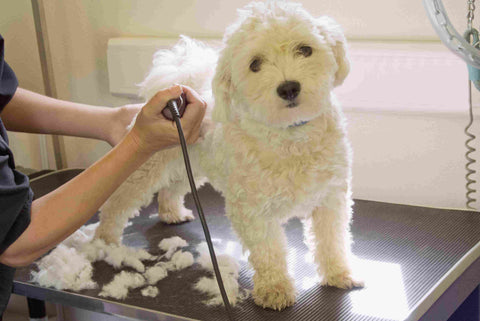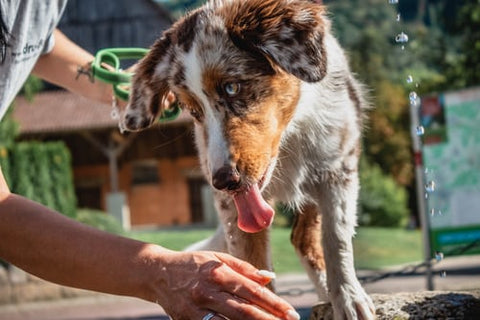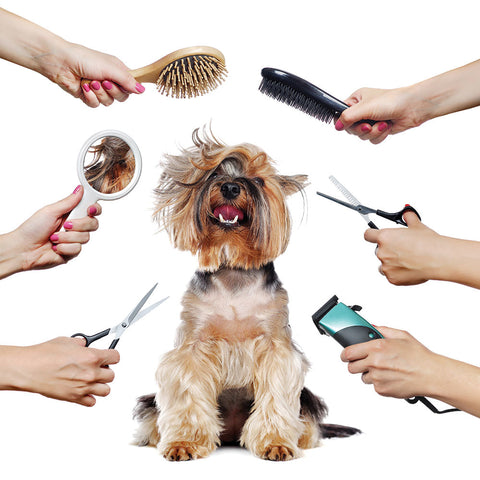Introduction
Begin by explaining the importance of eye care for dogs. Highlight how dogs' eyes are sensitive and prone to injury and infection during grooming. Emphasize the benefits of proper eye care, including preventing eye problems and ensuring the overall health and comfort of the dog.
Understanding Dog Eye Anatomy and Common Eye Problems
1. Basic Eye Anatomy
- Structure of the Eye: Describe the basic anatomy of a dog’s eye, including the cornea, iris, pupil, lens, retina, and surrounding tissues.
- Functions: Explain the functions of these parts and how they contribute to a dog’s vision and overall eye health.
2. Common Eye Problems
- Infections and Irritations: Discuss common eye problems such as infections, irritations, and conjunctivitis.
- Injuries: Highlight how injuries from grooming tools can cause scratches or damage to the cornea.
- Tear Stains: Explain the causes of tear stains and how to manage them during grooming.

Preparing for Eye-Safe Grooming
1. Choosing the Right Tools
- Blunt-Tipped Scissors: Recommend using blunt-tipped scissors to avoid accidental pokes and cuts.
- Gentle Brushes: Suggest using soft-bristled brushes to prevent irritation around the eyes.
- Eye Wipes: Discuss the importance of using specialized eye wipes to clean around the eyes without causing irritation.
2. Creating a Calm Environment
- Minimizing Stress: Emphasize the importance of creating a calm environment to reduce stress and ensure the dog remains still during grooming.
- Comfort Items: Suggest having comfort items, such as a favorite blanket or toy, to help keep the dog relaxed.

Steps for Safe Eye Care During Grooming
1. Inspecting the Eyes
- Regular Checks: Explain the importance of regularly checking the dog’s eyes for signs of redness, discharge, or irritation.
- Warning Signs: List warning signs of potential eye problems, such as excessive tearing, squinting, or cloudiness.
2. Cleaning Around the Eyes
- Using Eye Wipes: Provide a step-by-step guide on using eye wipes to gently clean around the eyes.
- Avoiding Direct Contact: Emphasize the importance of not touching the eyeball directly and only cleaning the surrounding area.
3. Trimming Hair Around the Eyes
- Blunt-Tipped Scissors: Describe how to use blunt-tipped scissors to carefully trim hair around the eyes to prevent irritation and improve visibility.
- Steady Hands: Highlight the need for steady hands and calm behavior to avoid startling the dog.
4. Handling Tear Stains
- Tear Stain Removers: Discuss the use of tear stain removers and how to apply them safely.
- Regular Cleaning: Emphasize the importance of regular cleaning to prevent tear stains from becoming a chronic issue.

Preventing Eye Injuries During Grooming
1. Proper Handling Techniques
- Gentle Restraint: Explain how to gently restrain the dog to prevent sudden movements that could lead to eye injuries.
- Supportive Hold: Suggest using a supportive hold that keeps the dog’s head steady while allowing for comfortable grooming.
2. Avoiding Sharp Objects
- Tool Selection: Emphasize the importance of selecting grooming tools with safety features, such as rounded edges and blunt tips.
- Careful Usage: Provide tips on carefully using grooming tools to avoid accidental contact with the eyes.
Post-Grooming Eye Care
1. Rinsing the Eyes
- Saline Solution: Recommend using a saline solution to rinse the eyes if there is any debris or irritant present.
- Proper Technique: Explain the proper technique for rinsing the eyes, including using a dropper or eye rinse bottle.
2. Monitoring for Issues
- Post-Grooming Checks: Emphasize the importance of monitoring the dog’s eyes for any signs of irritation or injury after grooming.
- Seeking Veterinary Care: Advise seeking veterinary care if any issues are noticed, such as persistent redness or discharge.
Long-Term Eye Care Strategies
1. Regular Grooming
- Consistent Schedule: Highlight the importance of maintaining a consistent grooming schedule to keep the area around the eyes clean and free of debris.
- Frequent Checks: Suggest incorporating eye checks into the regular grooming routine to catch any potential issues early.
2. Diet and Nutrition
- Nutrient-Rich Diet: Discuss the importance of a nutrient-rich diet for overall eye health, including foods high in vitamins A and E.
- Supplements: Recommend supplements that support eye health, such as omega-3 fatty acids.
Dealing with Specific Eye Conditions
1. Dry Eye
- Symptoms and Causes: Explain the symptoms and causes of dry eye in dogs.
- Management Tips: Provide tips on managing dry eye, including using prescribed eye drops and keeping the eyes clean.
2. Conjunctivitis
- Signs of Conjunctivitis: Describe the signs of conjunctivitis, such as redness, swelling, and discharge.
- Treatment Options: Discuss treatment options, including veterinary care and prescribed medications.
Case Studies and Testimonials
1. Real-Life Experiences
- Owner Testimonials: Share testimonials from dog owners who have successfully managed their dogs’ eye care during grooming.
- Positive Outcomes: Highlight the positive outcomes and benefits of diligent eye care practices.
Conclusion
Summarize the key points about safe eye care during grooming, emphasizing the importance of preparation, proper techniques, and regular monitoring. Highlight the benefits of maintaining good eye health for the dog’s overall well-being.
Call to Action
Encourage readers to implement these eye care tips during grooming and to share their experiences or additional tips in the comments section. Invite them to subscribe to the blog for more pet care tips and advice.
